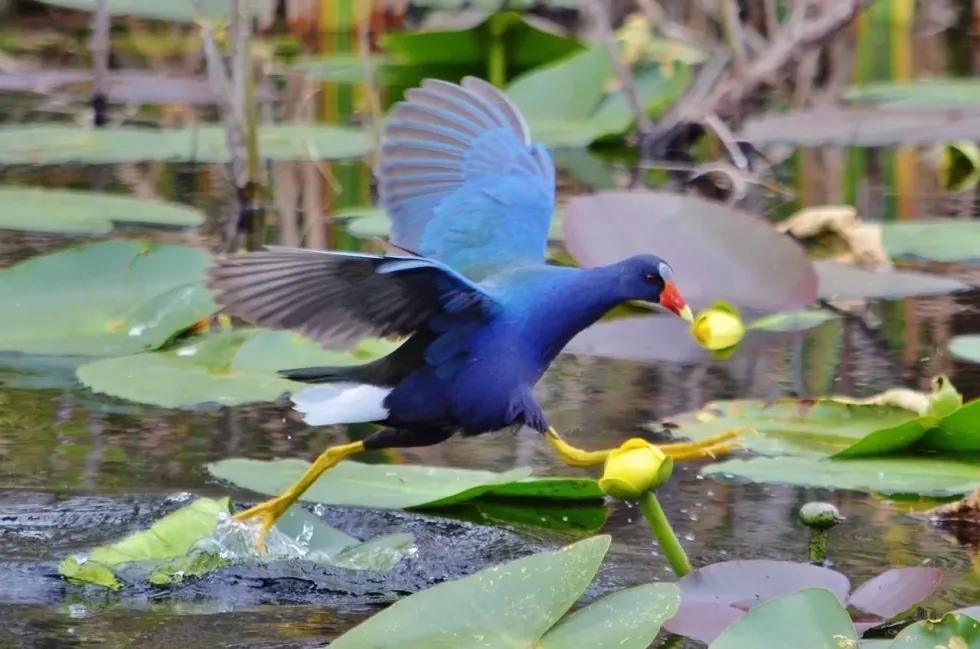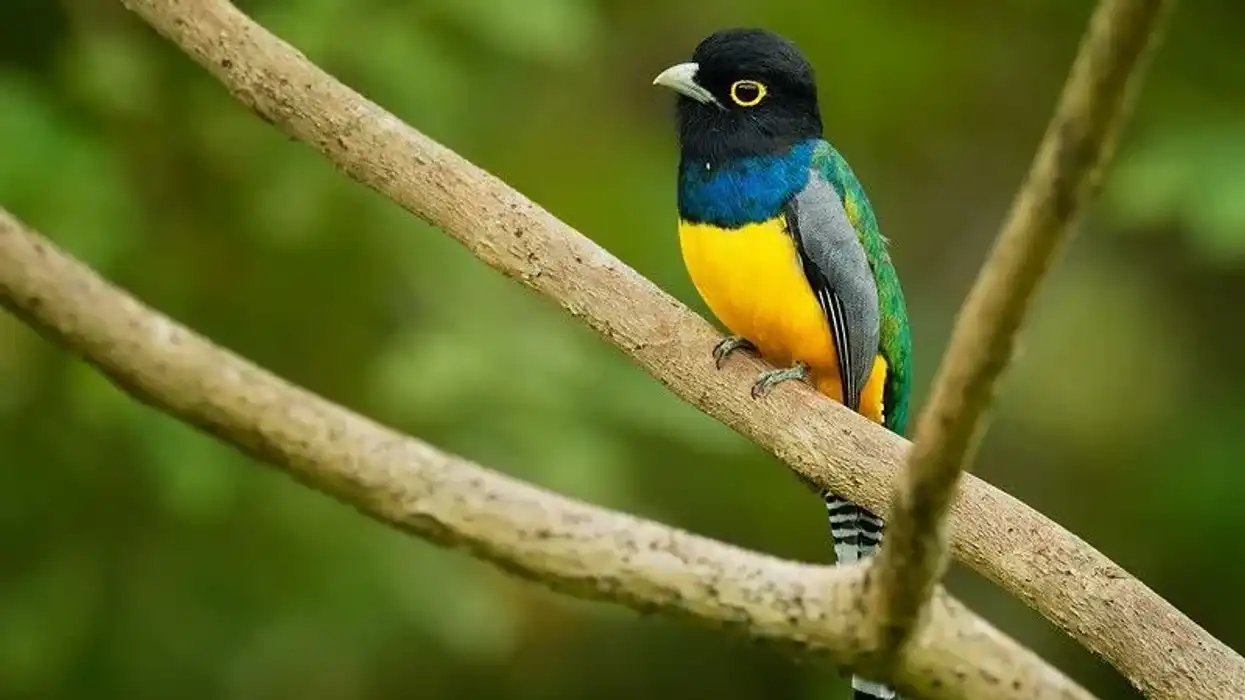A purple gallinule (Porphyrio martinicus ) is also commonly referred to as the American purple gallinule that belongs to the family of Rallidae.
They are known all around the world for their contrasting and beautiful appearance with a variety of bright colors that makes them stand out from others.
These birds are well suited to living in wetlands and swamplands that offer abundant sources of vegetation and freshwater near them. Let’s take a look at the purple gallinule (Porphyrio martinicus) and some of the other characteristics and qualities of this beautiful bird.
After reading these interesting facts about these birds of North America and the nests they live in, do check out our other articles on Carolina parakeet facts and resplendent quetzal facts as well.
Purple Gallinule Interesting Facts
What type of animal is a Purple Gallinule?
A purple gallinule (Porphyrio martinicus ) is a chicken-sized railbird that is one of the similar species amongst the Gruiformes order, meaning ‘crane-like’, and is placed amongst the order with other rails, crakes, and cranes.
What class of animal does a Purple Gallinule belong to?
A purple gallinule belongs to the class Aves, order Gruiformes, and family Rail. These birds have very compact bodies with long toes and legs that aid them to walk in their habitats and live in a nest.
How many Purple Gallinules are there in the world?
A recent study provided by North American Breeding Bird Survey suggested that their population is declining rapidly and accounted for a rough estimate which reflected that there are only around 10,000 purple gallinules left in the world.
Where does a Purple Gallinule live?
The American purple gallinule (Porphyrio martinicus) is known to travel, nest, and migrate to areas all over the world. They cover a huge range of places all around the world starting from the southeast United States, Mexico, Central and South America, and into Argentina.
What is a Purple Gallinule's habitat?
Purple gallinules of order Gruiformes, family Rail, are spread over North America, Central America, and South America. They are also known to travel to different places in search of freshwater lakes, ponds, and swamps.
Who do Purple Gallinules live with?
These birds prefer living in pairs and large communal groups to provide protection and safety for their species.
How long does a Purple Gallinule live?
Purple gallinules are known to have a long lifespan amongst birds that is around 22 years but they have been known to live for up to 25 years.
How do they reproduce?
The purple gallinule is known to lay around six eggs at once, which are known to hatch in 15-18 days, with the highest clutch recorded to date being eight eggs. These birds usually mate between May-August in North America, which may extend until November in South America.
Purple gallinule birds are highly territorial and monogamous and are known to breed in marshy areas including rice fields.
What is their conservation status?
Although their population has been decreasing in various areas due to habitat loss, they have been placed under the category of Least Concern by the IUCN Red List.
Purple Gallinule Fun Facts
What do Purple Gallinules look like?

A purple gallinule is one of the most beautiful birds listed amongst the large-sized aquatic birds that have short wings and tails. They have a compact bodies with small wings and long bright yellow legs and feet.
They have a variety of colors on their body starting from their pale blue head, purple and blue body, green back and wings, a baby blue frontal field just above their red and yellow bill, red eyes, and purple-colored neck, breast, and body.
How cute are they?
These birds are equally cute and beautiful and can be easily identified by looking at their colors, beak, and legs.
How do they communicate?
These birds of North America make a variety of sounds, with the most common sound being ‘kek kek kek’ which they usually make while flying to communicate with one another.
How big is a Purple Gallinule?
Purple gallinules are also known for their contrasting and beautiful colors and grow within a range of 10-15 in (25-38 cm) in length, having a wingspan of 22 in (56 cm).
How fast can a Purple Gallinule fly?
They are known to fly fast and have adapted themselves to cover great distances and also to run fast over floating vegetation and in wetlands.
How much does a Purple Gallinule weigh?
A purple gallinule is one of the larger species of aquatic birds. The purple gallinule's range of weight is 25-27 oz (709-765 g). The males are usually somewhat bigger and heavier as compared to the females.
What are the male and female names of the species?
There are no specific names given to male or female purple gallinules.
What would you call a baby Purple Gallinule?
The young ones and babies of purple gallinules are referred to as nestlings, hatchlings, or chicks, just like other bird species.
What do they eat?
Even though they are omnivore creatures, their primary diet consists of a variety of plant leaves, seeds, tubers, flowers, and fruits of aquatic and terrestrial plants, such as lotus, hydrallis, water lilies, and many more. They also eat beetles, bees, worms, frogs, small fish, spiders, leeches, ants, snails, grasshoppers, and eggs and young of other birds.
Are they dangerous?
There is no incident reported to date which has proved that these medium-sized birds have caused any harm to humans. Regardless, this species is not violent or aggressive, but they can be aggressive if their eggs, young ones, or their life is threatened.
They are also known to be aggressive while defending their territory from a variety of other animals.
Would they make a good pet?
Purple gallinules, also referred to as purple swamphens, are omnivore creatures that are also known to migrate from one place to another in search of food and habitat. These birds are not family-friendly and are not considered pets by pet owners.
If you are looking to keep purple gallinules as a pet bird at your house, they are not suited or adapted to homes.
Did you know...
As all of you might be having a problem with pronouncing the name, purple gallinule is pronounced as ‘pur-pul’ for purple and ‘gal-uh-nool’ or ‘gal-uh-nyool’.
Although this species seems like they usually spend their time in the nest and fly only short distances, they are found almost all around the world.
How has the Purple Gallinule adapted?
A purple gallinule is also known as the yellow-legged gallinule or American purple gallinule and is one of the few birds that has made great adaptations to altered human environments in the form of big legs and toes which makes it easier for them to walk on water lilies, and other flowers, in wetlands and swamp areas.
The young birds also use their tiny claws to move around in their habitat of wetlands where it is very difficult for others to move and hunt.
How are people affecting the Purple Gallinule?
As we have already seen, purple gallinules have been listed amongst the category of Least Concern under the IUCN Red List, but their population is declining day by day. Their population decline over the last 20-30 years has impacted around 76 % of the decline overall which is mainly caused due to habitat loss.
These birds have also been declared vulnerable in certain countries due to changes in water quality, habitat loss due to human intervention, loss of wetlands, pollution, and water levels which ultimately affect them.
Here at Kidadl, we have carefully created lots of interesting family-friendly animal facts for everyone to discover! Learn more about some other birds including California quail facts, or eastern kingbird facts.
You can even occupy yourself at home by coloring in one of our free printable purple gallinule bird coloring pages.










